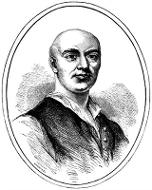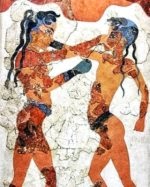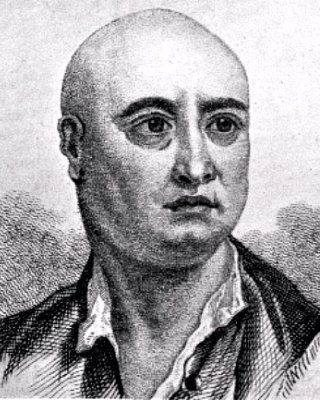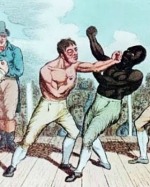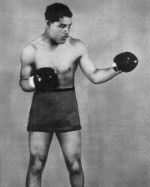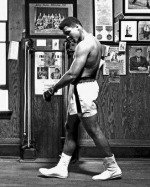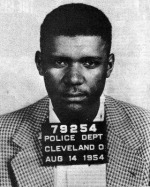Sam Langford – The World Champion That Never Was
Talk the Talk
Sam Langford and his contemporaries would often compete in no-decision contests.
Also known as newspaper decisions, these exhibition matches would be just as fierce as any
other fight with the boxers battling for pride as well as the purse.
Walk the Walk
A short man at around five foot seven inches, Sam Langford had unusually long reach for his size because of his broad shoulders and was as close to a complete fighter as you
can get.
He was a clever boxer who could fight on the inside or on the outside and could be a long, middle or short distance fighter depending on the man in front of him.
What’s more, he could brawl with the best of them and even when he moved up through the weights, his punch was devastating and his jaw remained solid.
Boxing Quote
“The hell I feared no man! There was one man, he was even smaller than I, and I wouldn’t fight because I knew he would flatten me.
I was afraid of Sam Langford.”
~ Jack Dempsey ~
~ Jack Dempsey ~
Samuel Edgar Langford, more commonly known as Sam Langford, is considered by many pundits to be one of the greatest
boxers in American history. He fought many of the top fighters of his era from lightweights to heavyweights winning far more than he lost, despite this he was never given a
fair chance at becoming the world champion.
This was at least in part because he was Black and in the early twentieth century, the colour line was all too often drawn in boxing.
It can also be argued that he was so good, that even some of the most respected champions of the day feared losing their titles to him.
Born in Weymouth, Nova Scotia, probably on March 4, 1885, he spent much of his career fighting out of Boston earning him the nicknames the Boston Terror, the Boston Bonecrusher or more commonly the Boston Tar Baby. Langford’s record is a matter of some confusion but it can be said that he had at least 293 fights, winning at least 167, 117 by way of knockout, with 38 defeats and 85 fights that were draws or no decisions.
Sam Langford's Early Career
His first recorded professional fight came in 1902 when he knocked out Jack McVicker in the fifth round of a lightweight contest. Right from the start he was fighting far more experienced men and in 1903 he was already on his twenty-sixth professional contest in which he beat his idol Joe Gans, then the lightweight world champion, in a fifteen-round nontitle fight. While it is true that Gans had fought the day before and then spent the evening drinking and travelling, for a fighter in his first year as a professional boxer to beat one of the best lightweights in the history of boxing in America is still an amazing achievement.
He soon began to move up in weight and in 1904, he battled it out with another great fighter, world welterweight champion Joe Walcott. Sources vary on whether or not this was a shot at the title but either way, the two fighters drew after a fifteen-round war that many spectators felt Langford should have won.
Sam Langford Vs. Jack Johnson
Two years later at around twenty years old, he was facing the great Jack Johnson, who beat the much younger and much lighter man on a points decision after fifteen gruelling rounds. In 1908 Johnson made boxing history by becoming the first Black world heavyweight champion causing upset within the sport and triggering the hunt for so-called the great white hope. Many believed a rematch with Langford was on the cards but for Johnson, the money was in fighting White contenders so like many White champions that came before and after him, he ‘drew the colour line’, freezing out boxers like Langford and refusing to give them a shot at the title.
Promoters and boxing officials would also be against title fights against two Black contenders as they wanted a White champion, especially in the heavyweight division for both racial and financial reasons. In fact, it would take until 1937 for the great Joe Louis to become the second Black boxer to hold the coveted heavyweight title. British boxing writer James “Jimmy” Butler, author of the acclaimed book Kings of the Ring met Langford while he was in the UK who told him that the then-heavyweight champion Jack Johnson wouldn’t give him a rematch. Butler wrote:
"That, as a matter of fact, was the plain and unvarnished truth. Johnson did dodge a meeting with the Boston Tar Baby after their terrific clash at Chelsea, Massachusetts ... Johnson just scraped home on points after fifteen rounds, but I think he learned enough to realise that if he ever got into the same ring with Langford again, those gigantic arms and shoulders would make short work of sweeping him off his throne".
Johnson indeed dodged a rematch with Langford, when promoter Hugh “Huge Deal”’ McIntosh tried to set the fight up, Johnson admitted that he was drawing the colour
line and stated, “I don’t want to fight that little smoke ... he’s got a chance to win against anyone in the world. I’m the first Black champion and I’m going to be the
last.”
However, their 1906 fight probably wasn’t as close as many claimed and later reports that Langford had put Johnson on the canvas were probably untrue. Langford’s long-time
manager Joe Woodman, when asked directly years later if his fighter decked Johnson is reported to have replied:
"You’ve got me ... Langford never dropped Johnson. But I was anxious to fix up another fight between the two and, knowing Jack’s pride, I invented the story of that knockdown to goad him into the ring against Sam again ... Although it never happened, all the newspapermen believed it. They just never took the trouble to investigate. That knockdown was just a publicity gimmick".
Blind Fury
Despite being denied a shot at the title Sam Langford fought on, repeatedly fighting other Black fighters
who were also victims of the colour line in boxing; he fought Joe Jeannette thirteen times, Sam McVey thirteen times and Harry Wills eighteen times. When he came up against
White opponents, he often had to take it easy and allow them to last a few rounds so as not to insight the crowd and to ensure the promoters would allow him future
fights.
Many of the fighters he faced were much larger and he often gave away forty pounds or more but his sheer punching power, ability to take a hit and his canny boxing brain
allowed him to compete with men much heavier and usually taller than him. This suited Langford as there was usually more money to be made in the heavyweight division. However, eventually the punishment he received from fighting on average more than ten times a year took its toll.
An eye injury sustained in a 1917 bout against Fred Fulton led
to him losing much of the sight in his left eye. His manager Joe Woodman tried in vain to get Langford to quit after this and when he couldn’t persuade him, he dissolved their
partnership. Woodman later recalled:
"Sam got badly busted up around the eyes in that bout, and I was afraid he’d go blind if he kept fighting. I told Sam he’d better quit, but he was stubborn. He insisted he’d keep going. I said it was dangerous for him, that he’d probably lose his eyesight and I didn’t want to be held responsible. I argued and pleaded but it did no good. So we parted. I was right. Sam did keep fighting and eventually became blind. It was too bad. He was a great fighter and one of the finest chaps, personally, I’ve ever had anything to do with."
After parting ways with Woodman, Langford continued his career with impaired vision in one eye, still out boxing and out-punching most who stood before him. In 1922, he beat future middleweight champion Tiger Flowers in the second round but sustained an injury to his good
eye that left him all but blind.
With failing sight, the ageing fighter still strove for a shot at the title and went to Doc Kearns, manager of the new heavyweight champion
Jack Dempsey to ask for a fight. Perhaps summing up the story of Langford’s career, Kearns denied him the chance, telling him, “Sam, we were looking for somebody
easier." Despite increasingly serious visual impairment, he still fought on and in 1923 became the heavyweight champion of Mexico. He later stated:
"I went down to Mexico ... with this here left eye completely gone and the right eye just seeing shadows. It was a cataract. They matched me up with Kid Savage for the title. I was bluffing through that I could see but I gave myself away. They bet awful heavy on the kid when the word got round. I just felt my way around and then, wham, I got home. He forgot to duck and I was the heavyweight champion of Mexico".
Life After Boxing
After walking to the wrong corner in a fight in 1926, Langford could no longer conceal his sight problems and
had his license revoked, forcing him into retirement probably at the age of 41. Soon after, the great boxer disappeared into obscurity until Al Laney of the New York Herald
Tribune tracked him down in 1944, finding him living in a small room in Harlem, all alone, penniless and now completely blind.
Laney interviewed the former
boxer and after publishing an article about him, set up a fund for him with a hat regularly being passed around on Langford's behalf at local fights. For the rest of his
days, he lived a relatively comfortable life, passing away on January 12, 1956, aged around 70. Ten weeks before he passed, Sam Langford was entered into the Boxing Hall of
Fame, at the time he was the only non-world titleholder to be given the honour. Soon after he stated, "Don’t nobody need to feel sorry for old Sam. I had
plenty of good times. I been all over the world. I fought maybe 600 fights, and every one was a pleasure!"
Written by Andrew Griffiths – Last updated 25/08/2023. If you like
what you see, consider following the History of Fighting on social media.
Further Reading:
Clay Moyle. [Internet]. 2017. Sam Langford: History’s Forgotten Boxer. BlackPast.org. Available from: http://www.blackpast.org/perspectives/sam-langford-history-s-forgotten-boxer [Accessed May 12, 2018].
Kieran Mulvaney. [Internet]. 2007. The greatest fighter almost nobody knows. ESPN. Available from: http://www.espn.com/espn/blackhistory2007/news/story?id=2755803 [Accessed May 12, 2018].
Mike Casey. [Internet]. 2012. Pocket Battleship: Sam Langford. Boxing.com. Available from: http://www.boxing.com/pocket_battleship_sam_langford.html [Accessed May 12, 2018].
Paul Wheeler. [Internet]. 2016. On This Day: Sam Langford was born. Boxing News. Available from: http://www.boxingnewsonline.net/on-this-day-sam-langford-was-born [Accessed May 12, 2018].
Sam Langford. [Internet]. 1999. International Boxing Hall of Fame. Available from: http://www.ibhof.com/pages/about/inductees/oldtimer/langford.html [Accessed May 12, 2018].
Sam Langford. [Internet]. 2018. Canada’s Sports Hall of Fame. Available from: http://www.sportshall.ca/stories.html?proID=60&catID=all [Accessed May 12, 2018].
Travis Fleming. [Internet]. 2015. Was Sam Langford the Greatest Fighter in the History of Boxing? Ring Side Report. Available from: http://ringsidereport.com/?p=51501 [Accessed May 12, 2018].
More Boxing History
Boxing History Home
The history of boxing dates back in one form or another as far as civilisation itself with ancient Greek boxing even being a part of the early Olympic Games. Modern boxing rules have made the sport safer for the fighters and more entertaining for the crowds, resulting in pugilism becoming one of the most popular athletics events on the planet today.
The history of boxing dates back in one form or another as far as civilisation itself with ancient Greek boxing even being a part of the early Olympic Games. Modern boxing rules have made the sport safer for the fighters and more entertaining for the crowds, resulting in pugilism becoming one of the most popular athletics events on the planet today.
Boxing in the Ancient World
Ancient boxing dates back to the Samarian culture and probably beyond and is known to have also been a part of the Egyptians and Minoan civilisations. It became an event in the ancient Olympic games in Greece in 688 BCE, and ancient Roman boxing was also practiced by athletes, gladiators and Roman soldiers.
Ancient boxing dates back to the Samarian culture and probably beyond and is known to have also been a part of the Egyptians and Minoan civilisations. It became an event in the ancient Olympic games in Greece in 688 BCE, and ancient Roman boxing was also practiced by athletes, gladiators and Roman soldiers.
Boxing in the 18th Century
Modern boxing history really began to develop into the sport known and loved today in the 18th century. Bare knuckled boxing contests began to be regulated and safety measures also began to be put in place. However, the period was also marred by controversy as it saw the first instances of corruption in the form of prize fighters taking payoffs and intentionally losing fights.
Modern boxing history really began to develop into the sport known and loved today in the 18th century. Bare knuckled boxing contests began to be regulated and safety measures also began to be put in place. However, the period was also marred by controversy as it saw the first instances of corruption in the form of prize fighters taking payoffs and intentionally losing fights.
Boxing in the 19th Century
This list of bare-knuckle boxers from the 19th century charts those who are generally accept as being World Champions. It includes some of the best fighters from this period in boxing history starting with Jem Belcher, the first champ of the new century and concluding with Jem Mace, who made the switch from bare-knuckle boxing to using boxing gloves after the introduction of the Queensbury Rules.
This list of bare-knuckle boxers from the 19th century charts those who are generally accept as being World Champions. It includes some of the best fighters from this period in boxing history starting with Jem Belcher, the first champ of the new century and concluding with Jem Mace, who made the switch from bare-knuckle boxing to using boxing gloves after the introduction of the Queensbury Rules.
Post-Queensbury Rules Boxing Culture
With the introduction of the Queensbury Rules in 1867, boxing culture was dramatically changed. The safety of the boxers was much improved though bare-knuckle boxing was still popular and as brutal as ever. For black boxers however, things actually changed for the worse as it became increasingly difficult for many of them to reach their full potential as a result of institutional racism.
With the introduction of the Queensbury Rules in 1867, boxing culture was dramatically changed. The safety of the boxers was much improved though bare-knuckle boxing was still popular and as brutal as ever. For black boxers however, things actually changed for the worse as it became increasingly difficult for many of them to reach their full potential as a result of institutional racism.
Joe Louis
Joe Louis (The Brown Bomber) was an American boxer and widely considered to be one of the greatest world heavyweight champions of all time. He became an American hero when he defeated the German Max Schmeling, then later through his work promoting the war effort. Despite his considerable success, later in his career he would face massive debts due to unfair treatment by the taxman.
Little Known Facts About Muhammad Ali
Muhammad Ali was a three-time heavyweight boxing champion and is widely regarded as the greatest boxer of all time, as well as one of the most influential sportsmen of the 20th century. This selection of little-known facts about ‘the Louisville Lip’ show he led an interesting and varied life, both inside and outside the ring.
Muhammad Ali was a three-time heavyweight boxing champion and is widely regarded as the greatest boxer of all time, as well as one of the most influential sportsmen of the 20th century. This selection of little-known facts about ‘the Louisville Lip’ show he led an interesting and varied life, both inside and outside the ring.
The Reign of Don King
Don King is an influential American boxing promoter who has staged some of the biggest fights in boxing history, increased the prize money earned by fighters and considerably raised public interest in the sport, all in his own charismatic and outspoken style. Despite this, King’s career has been constantly marred by controversy leading to him being both loved and hated in the world of boxing.
Don King is an influential American boxing promoter who has staged some of the biggest fights in boxing history, increased the prize money earned by fighters and considerably raised public interest in the sport, all in his own charismatic and outspoken style. Despite this, King’s career has been constantly marred by controversy leading to him being both loved and hated in the world of boxing.
The images on this site are believed to be in the public domain, however, if any mistakes have been made and your copyright or intellectual rights have been breeched, please contact andrew@articlesonhistory.com.



